
Cladistics is an approach to biological classification in which organisms are categorized in groups ("clades") based on hypotheses of most recent common ancestry. The evidence for hypothesized relationships is typically shared derived characteristics (synapomorphies) that are not present in more distant groups and ancestors. However, from an empirical perspective, common ancestors are inferences based on a cladistic hypothesis of relationships of taxa whose character states can be observed. Theoretically, a last common ancestor and all its descendants constitute a (minimal) clade. Importantly, all descendants stay in their overarching ancestral clade. For example, if the terms worms or fishes were used within a strict cladistic framework, these terms would include humans. Many of these terms are normally used paraphyletically, outside of cladistics, e.g. as a 'grade', which are fruitless to precisely delineate, especially when including extinct species. Radiation results in the generation of new subclades by bifurcation, but in practice sexual hybridization may blur very closely related groupings.
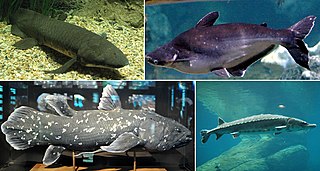
Osteichthyes, popularly referred to as the bony fish, is a diverse taxonomic group of fish that have skeletons primarily composed of bone tissue. They can be contrasted with the Chondrichthyes, which have skeletons primarily composed of cartilage. The vast majority of fish are members of Osteichthyes, which is an extremely diverse and abundant group consisting of 45 orders, and over 435 families and 28,000 species. It is the largest class of vertebrates in existence today. The group Osteichthyes is divided into the ray-finned fish (Actinopterygii) and lobe-finned fish (Sarcopterygii). The oldest known fossils of bony fish are about 425 million years old, which are also transitional fossils, showing a tooth pattern that is in between the tooth rows of sharks and bony fishes.

In biology, phylogenetics is the study of the evolutionary history and relationships among or within groups of organisms. These relationships are determined by phylogenetic inference methods that focus on observed heritable traits, such as DNA sequences, protein amino acid sequences, or morphology. The result of such an analysis is a phylogenetic tree—a diagram containing a hypothesis of relationships that reflects the evolutionary history of a group of organisms.

Synbranchiformes, often called swamp eels, is an order of ray-finned fishes that are eel-like but have spiny rays, indicating that they belong to the superorder Acanthopterygii.
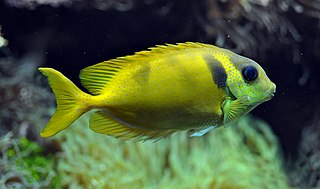
Neopterygii is a subclass of ray-finned fish (Actinopterygii). Neopterygii includes the Holostei and the Teleostei, of which the latter comprise the vast majority of extant fishes, and over half of all living vertebrate species. While living holosteans include only freshwater taxa, teleosts are diverse in both freshwater and marine environments. Many new species of teleosts are scientifically described each year.
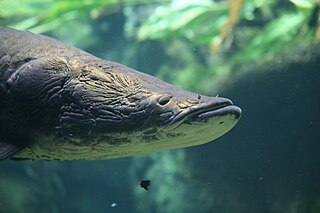
Osteoglossomorpha is a group of bony fish in the Teleostei.
Evolutionary taxonomy, evolutionary systematics or Darwinian classification is a branch of biological classification that seeks to classify organisms using a combination of phylogenetic relationship, progenitor-descendant relationship, and degree of evolutionary change. This type of taxonomy may consider whole taxa rather than single species, so that groups of species can be inferred as giving rise to new groups. The concept found its most well-known form in the modern evolutionary synthesis of the early 1940s.
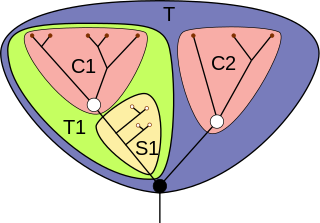
In phylogenetics, the crown group or crown assemblage is a collection of species, composed of the living representatives of the collection, the most recent common ancestor of the collection, and all descendants of the most recent common ancestor. It is thus a way of defining a clade, a group consisting of a species and all its extant or extinct descendants. For example, Neornithes (birds) can be defined as a crown group, which includes the most recent common ancestor of all modern birds, and all of its extant or extinct descendants.

Leaffishes are small fishes of the family Polycentridae. According to FishBase, it only includes the genera Monocirrhus and Polycentrus from fresh and brackish water in tropical South America. Although included in the Asian leaffish family Nandidae by FishBase, most recent authorities place the African Afronandus and Polycentropsis in Polycentridae. Polycentridae were formerly placed in the order Cichliformes but are now regarded as being incertae sedis in the subseries Ovalentaria in the clade Percomorpha.

Stylephorus chordatus, the tube-eye or thread-tail, is a deep-sea fish, the only fish in the genus Stylephorus and family Stylephoridae.

The Syngnathiformes are an order of ray-finned fishes that includes the trumpetfishes and seahorses.

Holostei is a group of ray-finned bony fish. It is divided into two major clades, the Halecomorphi, represented by a single living species, the bowfin, as well as the Ginglymodi, the sole living representatives being the gars (Lepisosteidae), represented by seven living species in two genera. The earliest members of the clade appeared during the Early Triassic, over 250 million years ago.
Phylogenetic nomenclature is a method of nomenclature for taxa in biology that uses phylogenetic definitions for taxon names as explained below. This contrasts with the traditional approach, in which taxon names are defined by a type, which can be a specimen or a taxon of lower rank, and a description in words. Phylogenetic nomenclature is currently regulated by the International Code of Phylogenetic Nomenclature (PhyloCode).
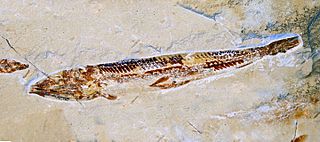
Prionolepis is a genus of prehistoric ray-finned fish belonging to the order Alepisauriformes.

Fish are very diverse animals and can be categorised in many ways. This article is an overview of some of ways in which fish are categorised. Although most fish species have probably been discovered and described, about 250 new ones are still discovered every year. According to FishBase about 34,800 species of fish had been described as of February 2022, which is more than the combined total of all other vertebrate species: mammals, amphibians, reptiles and birds.
The Willi Hennig Society "was founded in 1980 with the expressed purpose of promoting the field of phylogenetic systematics." The society is represented by phylogenetic systematists managing and publishing in the peer-reviewed journal titled Cladistics. The society is named after Willi Hennig, a German systematic entomologist who developed the modern methods and philosophical approach to systematics in the 1940s and 1950s. The society is also involved in reconstructing the tree of life. The current president, Ward Wheeler of the American Museum of Natural History, was elected in 2016, succeeding Dr. Jyrki Muona.

Arapaiminae is a subfamily of freshwater osteoglossiform (bony-tongued) fishes belonging to the family Osteoglossidae. It includes the South American arapaimas of the Amazon and Essequibo basins and the African arowana from the watersheds of the Sahelo-Sudanese region, Senegal, Gambia, and parts of Eastern Africa. This subfamily is sometimes raised to the rank of family, as Arapaimidae. A commonly used synonym is Heterotidinae, but according to the ICZN, Arapaiminae has priority.

the African leaffish is a species of African leaffish native to fresh waters of western Africa. Although placed in the family Nandidae by FishBase and by the 5th Edition of Fishes of the World many recent authorities place Polycentropsis in Polycentridae.

Percomorpha is a large clade of ray-finned fish that includes the tuna, seahorses, gobies, cichlids, flatfish, wrasse, perches, anglerfish, and pufferfish.
Coprothermobacterota is a newly proposed phylum of nonmotile, rod-shaped bacteria.















